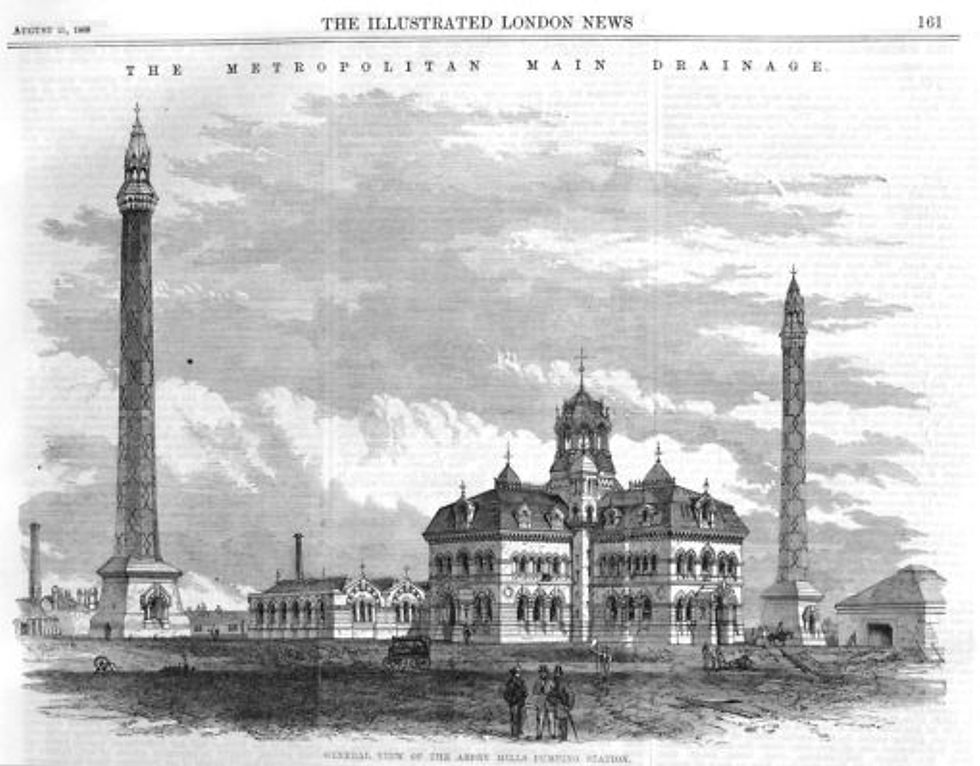
1. Robert Rawlinson’s fantastical array of industrial chimneys, The Builder, 25 April 1857, p. 23.
‘A tower is the creation of another century. Without a past it is nothing’ (Gaston Bachelard, The Poetics of Space, p. 25)
In 1853, The Builder pictured industrial Manchester ‘getting up the steam’ (2) – the city’s skyline filled with an almost impossible number of chimneys belching smoke and so tall that they dwarfed even Manchester’s church spires. Sublime – even Gothic – in their blackness, these chimneys were nevertheless strictly utilitarian in appearance: identical stacks of brick attached to equally stark mill and other factory buildings. Yet, only five years later, in 1858, The Builder pictured a new vision of industrial chimneys as a dreamscape (1). Assembled by the engineer Robert Rawlinson, these fantastical designs were chimneys that mimicked historical precedents, whether medieval Italian campaniles, Moorish minarets or the more recent clock tower of the Palace of Westminster. Rawlinson believed, in common with most Victorian designers, that history gave aesthetic meaning to structural form; according to Rawlinson, instead of ‘chimney’ being a ‘by-word for hideous structures’, it should be in tune with the models of the past that ‘have stood for ages as monuments of beauty.’

2. ‘Manchester, getting up the steam’, The Builder, 1853.
Yet, Rawlinson’s designs do more than simply dress up chimneys in attractive disguises; rather, they draw building into a potent kind of dream. As the phenomenologist Gaston Bachelard has emphasised in The Poetics of Space (1964), towers are more than simply structures; rather, they are primal images of verticality that illustrate the verticality of the human being. So, in our dreams we always go up towers (whereas we always go down into a cellar). Towers are images of ascension, the endless winding steps inside them leading to dreams of flight or transcendence. Chimneys may not in themselves be fertile dream spaces; yet, because they’re designed solely to carry polluting fumes above the city, they are almost pure images of verticality. By cloaking chimneys with images of the past, Rawlinson joins the pure vertical expression of industry with a whole succession of former dreams of ascension. He also humanises the industrial by bringing it within the compass of the verticality of the human being: people may not be able to literally ascend chimneys but, cloaked in the former dream images of bell towers and minarets, they can now do so in their imagination.

3. The Abbey Mills pumping station as seen in The Illustrated London News, 15 July 1868, p. 161.

4. Chimney of the Edgbaston waterworks, c.1870.
There are numerous Victorian chimneys that followed Rawlinson’s example: from those that adorned the extravagant Crossness (1862-65) and Abbey Mills pumping stations (3; 1865-68) in London, to the more diminutive but no less aestheticised chimney of the Edgbaston waterworks in Birmingham (4; c.1870), one of a pair of water towers that were thought to have inspired the title of J. R. R. Tolkein’s second book in his Lord of the Rings trilogy. Yet, perhaps nowhere was Rawlinson’s dream more closely realised than in Leeds’s Tower Works (5), where the steel pin manufacturer T. R. Harding brought together fine architecture into the industrial workplace in the form of three extraordinary chimney-towers: the first (right; 1866) based on the 13th-century Lamberti tower in Verona; the second (centre; 1899) inspired by Giotto’s 14th-century campanile for the Duomo in Florence; the third (left) a 1920s re-imagining of one of the numerous medieval defensive towers of San Gimignano in Tuscany.

5. Tower Works, Leeds showing the three chimneys based on Italian towers.

6. Candle Tower (2009), Leeds, next to the Tower Works.
This gathering of chimney-towers in Leeds’ Tower Works demonstrates that structures – even those with an essentially utilitarian purpose – can dream. For what else are these chimneys but towers brought into a new constellation of meaning, assembled from the fragments of the past, and born in the imagination? And even today, when our own megalomanic skyscrapers seem to abolish the kind of verticality that chimes with human being, there’s still a sense in which imagination still plays a part in the conception of some of our tall buildings: whether the Candle Tower (6, right; 2009) near the Tower Works (nicknamed the ‘leaning tower of Leeds’), or Manchester’s Beetham Tower (7, right; 2006) – a structure that, despite its sleek modernity, nevertheless still answers the age-old appeal of the tower, as seen in its early Victorian forebear on the Rochdale Canal (7, left).

7. Beetham Tower (2006), Manchester, next to an early Victorian factory on the Rochdale Canal.
#historicism #symbolism #JRRTolkein #PalaceofWestminster #Verona #TheBuilder #chimneys #campanile #TowerWorks #AbbeyMillspumpingstation #Manchester #Giotto #Florence #RobertRawlinson #towers #Birmingham #Italy #minaret #Edgbastonwaterworks #GastonBachelard #Victorian #Lambertitower #SanGimignano #Leeds
Opmerkingen